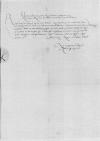List #5696
Sigismund I Jagiellon do Ioannes DANTISCUSCracow (Kraków), 1539-05-03
| odebrano [1539]-05-25 Rękopiśmienne podstawy źródłowe:
| ||||||
Tekst + aparat krytyczny + komentarzZwykły tekstTekst + komentarzTekst + aparat krytyczny
Reverendo in Christo Patri, domino
Reverende in Christo Pater, sincere nobis dilecte.
Quas petit Paternitas Tua a nobis dari litteras ad sanctissimum dominum nostrum, eas libenter sumus daturi. Ceterum de reiciendis in aliud tempus
Dat(um) or Dat(ae)⌈Dat(um)Dat(um) or Dat(ae)⌉
Ad mandatum regiae maiestatis proprium


 BNW, BOZ 953, f. 172v.
BNW, BOZ 953, f. 172v.